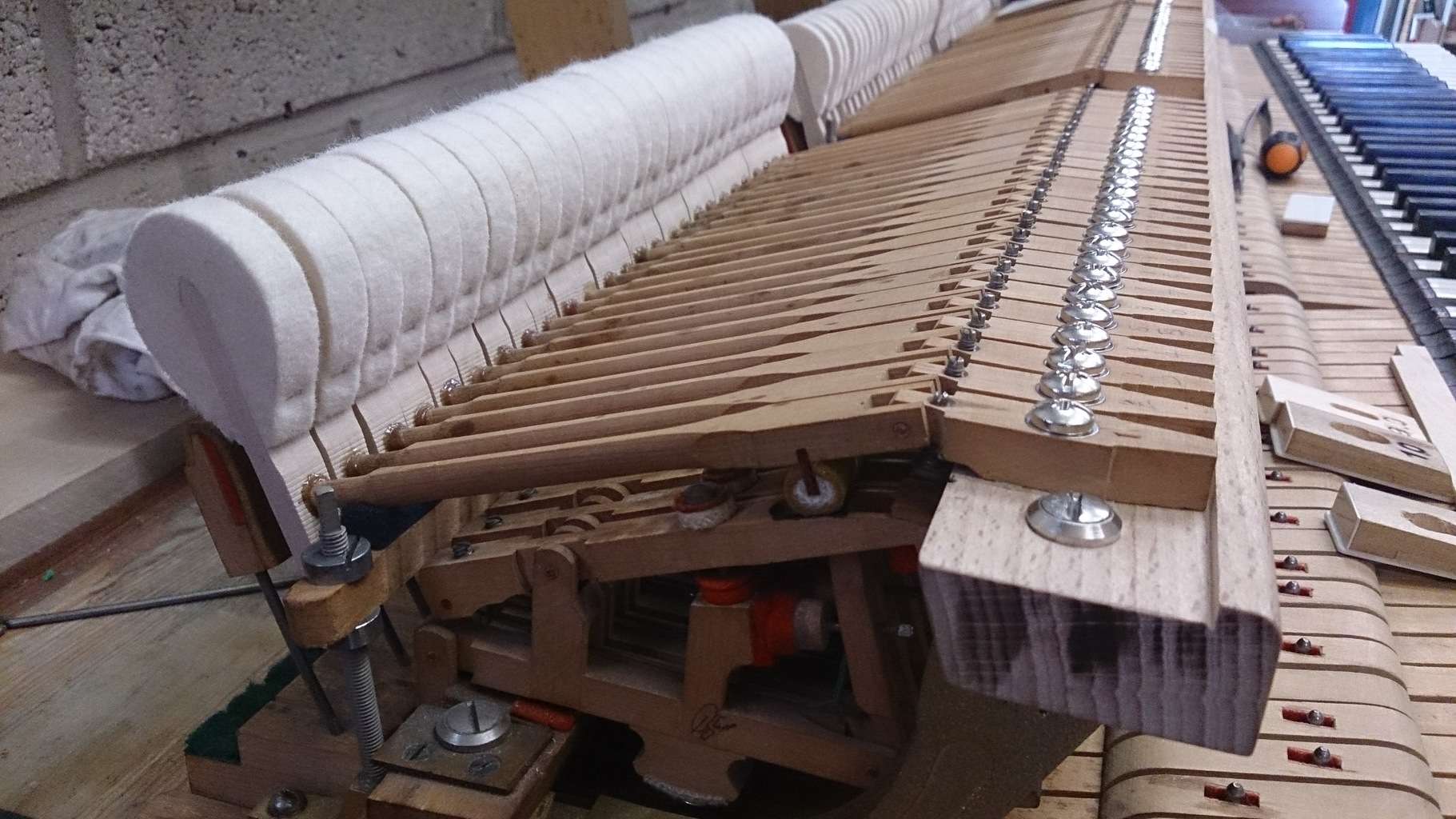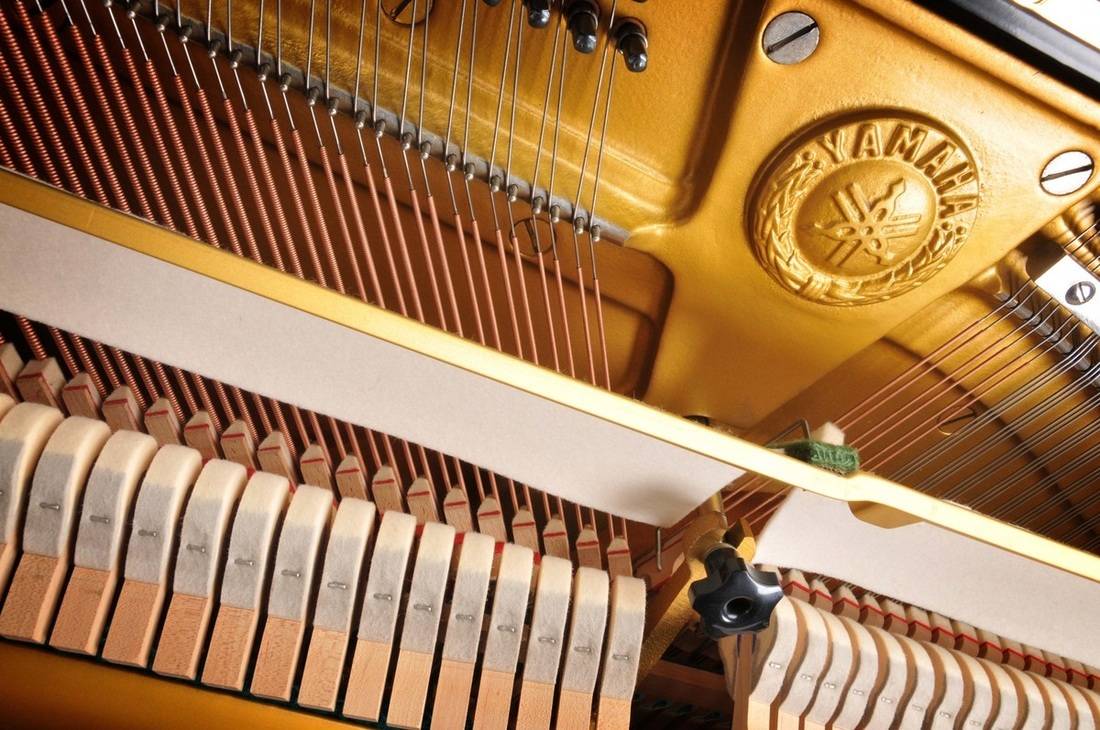The Yamaha U1 has a great history, as well as an enormous impact on the piano industry and is still playing a very very big role here at Merriam Pianos, as well as in the rest of the industry.
The Yamaha U1 is definitely a 100% Japanese made piano manufactured by the Yamaha Corporation, and this model dates back to the 1960s. Asia had an enormous impact on the development of the North American piano industry and really the piano Street worldwide.
After World War II the manufacturers in the United States really started focusing on lower cost, smaller, and to be honest very cheaply made pianos. In some ways the world of pianos was mirroring the auto industry where quality and lasting shelf-life wasn’t necessarily a focus.
All that changed very quickly when pianos like the Yamaha U1 started to cross the Pacific from Japan. People quickly figured out that for what they normally would have been paying for (supposedly a fairly decent midrange North American piano) they can get instrument like the U1 which delivered consistent action and a nice big sound from its 48 inch frame.
It it quite frankly obliterated dozens and dozens of manufacturers. Right from its outset it really had a big impact on the piano industry.
The Yamaha U1 has been made consistently in Japan through that entire history at this point. I know there’s been some talk on a few blogs or websites are even some dealers for the say that the U1 one is not made in Japan anymore.
Even though we’re not a new Yamaha dealer, we certainly do sell our fair share of used Yamaha’s, and it’s a product that I still have a very positive impression of. To this day the Yamaha U1 is still in fact made completely in Japan. There are other Yamaha models that are starting to do some outsourcing and are are starting to shift other factories in other countries.
For the time being, the U series is still 100% a Japanese product just as the K-series from Kawai is still a 100% Japanese product. The U1’s history as it came into North America is more than just talking about a specific model because the U1 and other models like K3 spawned essentially an entire sub industry of used pianos.
How the Yamaha U1 Came To North America
It’s a bit of a quirk that a lot of people are necessarily aware of. When a family in Japan buys a piano, they always purchase a piano brand new for a combination of both religious and cultural beliefs.
It’s not considered a particularly tasteful thing to buy a used piano in Japan. I’m not an expert’s so I won’t get into the reasons why, but I do know that this is a major influence on the used Japanese Piano market.
In the 1970s and 1980s as more and more Yamaha’s and Kawai’s found their way into Japanese homes, people eventually started to I get rid of these instruments. It didn’t take very long for somebody to notice that these pianos are literally just being left on the side of the road still in completely working order.
Some enterprising importers and distributors began collecting these instruments and shipping them over to North America for sale. This started what most people will refer to as the grey market piano industry. If people in Japan had been open to the idea of buying used pianos, there would never of been a Japanese grey market history to begin with.
It’s just that particular cultural dynamic which forced this entire shift in the way that we buy used pianos. In the 70s and 80s, millions of these pianos were coming cross into North America, and it really changed the landscape.
All of the sudden companies like Yamaha were having to compete against themselves and there is all this literature that came out saying “don’t buy these grey market pianos… they were made for North America… they weren’t seasoned properly and you’re gonna run into a lot of issues…” Yes, we’re talking about a model but we’re also talking about an entire industry just within this one model.
These days most technicians and most authorities on the subject will agree that if the piano was well seasoned if it’s properly selected and you got a reputable dealer to take the time to make sure that the piano stabilizes check for any issues after that stabilization makes the risk of buying a grey market piano at this point quite low.
I think where the risk still exists is when you’re dealing with smaller dealers who just don’t have the resources or the time to let these instruments season once they’ve arrived. It’s not like there is an absence of risk, however if you choose the bright dealer or if you’re working with a really trustworthy technician that you’ve got some history with, this is something that’s all but completely mitigated.
The Yamaha U1 has a characteristically brighter sound than something like a Kawai. This is because they’ve always generally had slightly shorter but higher tension strings and this is produced to slightly more metallic or slightly a sharper attack to the note.
For people who really enjoy the Yamaha sound this is one of the nicest characteristics about it. It’s a very nice bright clear sound. It’s subjective so you’ve still got a good chunk of people who prefer a slightly darker mellow or sounda (something more akin to a Steinway or Kawai) but Yamaha has certainly developed a specific sound and they’re known for it at this point.
When you’re playing a pop song this really comes out in spades. It’s a really nice clear bright sound and when you’re pop or a heavier blues or even if you’re at a bar or having to fight through a bit of white noise, this is an ideal sound to do that with.
Yamaha’s always been fun to play as well because it’s really easy and nice loud sound. It’s something that at times if you’re playing some classical music you can run into a few control issues. Sometimes it’s nicer to be able to get a wider palette of sound that you might be used to on a few other brands, but certainly Yamaha has its place.
One of the reasons the Yamaha U1 is so ubiquitous in the industry is because they have not changed the name of the model over almost 40 years.
If you look at a company like Kawai that every time they go through significant design shift or there is a new generation of pianos they give it a new name. This is not unusual, there’s a lot of car companies will do this a lot of television or electronic componies will also do this.
With Yamaha, the U1 has remained called the you one throughout its entire history despite the fact that it’s actually gone through many evolutions of design some more successful in some a lot less successful. Despite the fact that there’s been better and worse years in terms of good designers or better craftsmanship, that brand name continues to build.
This is one of the reasons why it’s traditionally led the industry in terms of resale value. This is a big factor to consider because one of the biggest questions I get is “Why do we hear about all these you U1s but I don’t hear much as much about the Kawai K-series?” Well, you’ve got 40 years of global sales going up against maybe 10 years of global sales of course there are going to be more you U1s out there.
Moving forward the Yamaha U1 looks like it’s here to stay. Most markets in North America the U1 is going be selling between $8000 to $10,000. Its a little bit more than what the equivalent Kawai, but it still seems like a product that has a very high level of quality control and still has a characteristic bright sound to it. I know a lot of people who really enjoy contemporary music I personally still really loving sitting behind a Yamaha U1.
It’s nice to have this in contrast to the Kawai K 300 (an equivalent 48 inch Japanese piano) because they’re so different yet they share are such a common history.




